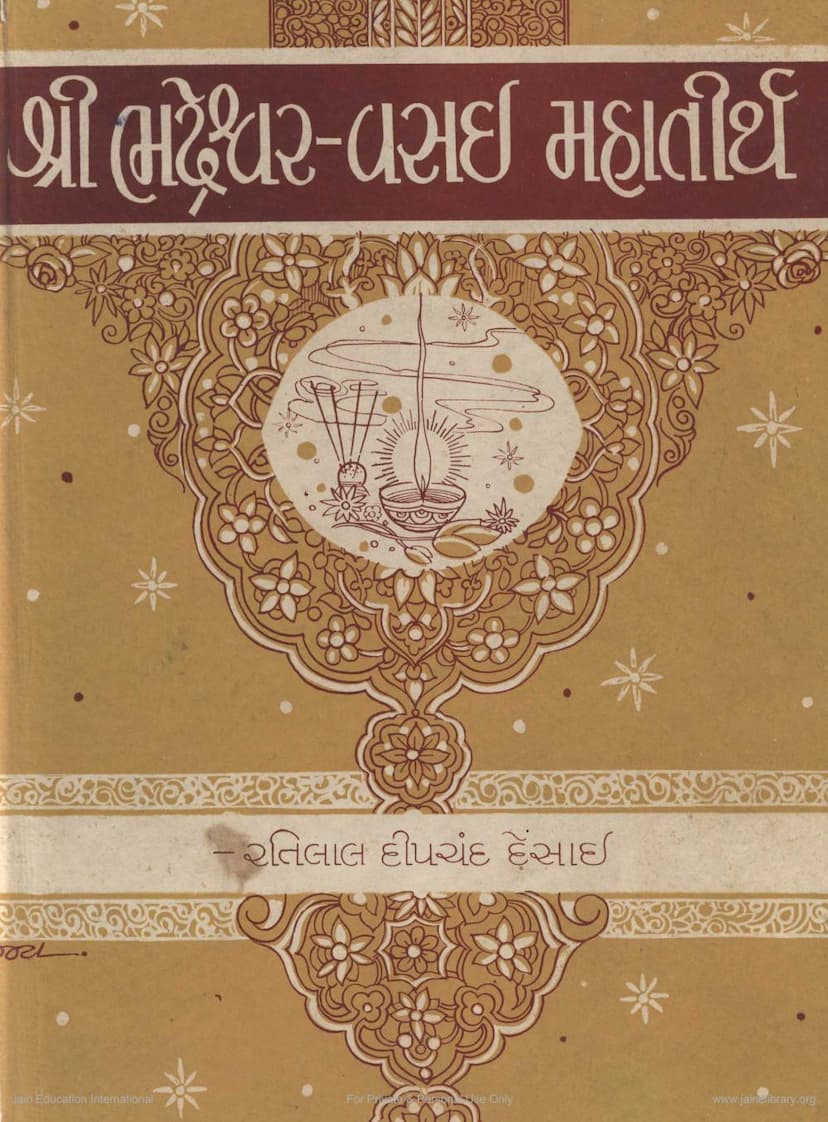Bhadreshwar Vasai Mahatirth
Added to library: September 1, 2025

Summary
Here is a comprehensive summary of the Jain text "Shri Bhadreshwar-Vasai Mahatirtha" by Ratilal D. Desai:
Book Title: Shri Bhadreshwar-Vasai Mahatirtha Author: Ratilal D. Desai Publisher: Gurjar Granthratna Karyalay, Ahmedabad
Overview:
This book is a detailed historical and devotional exploration of the ancient Jain pilgrimage site of Bhadreshwar-Vasai, located in the Kutch region of Gujarat, India. The author, Ratilal D. Desai, meticulously compiles information from various sources, including ancient manuscripts, inscriptions, legends, and historical accounts, to present a comprehensive narrative of the Tirtha's significance, its history, its architectural splendor, and its association with important Jain figures and events. The book also delves into the cultural and geographical context of the Kutch region, highlighting its unique characteristics and the deep-rooted Jain heritage it holds.
Key Themes and Content:
-
Introduction to Kutch: The book begins by introducing the Kutch region, describing its geography, its people known for their resilience, courage, and simple living, and its rich cultural heritage. It touches upon the significance of Kutch as a land of faith, devotion, and historical events.
-
Jainism in Kutch: Desai details the deep-rooted presence of Jainism in Kutch, mentioning the numerous Jain temples and pilgrimage sites, including the prominent Panchtirthi (five holy sites). It highlights the significant role of the Jain community (Mahajan) in the region's development and their strong adherence to Jain principles like Ahimsa (non-violence), Sanyam (restraint), and Tapasya (penance).
-
Bhadreshwar-Vasai Mahatirtha:
- Historical Significance: The text establishes the antiquity of Bhadreshwar-Vasai, tracing its history from ancient times, possibly even linking it to the Mahabharata era with the city of Bhadravati. It discusses its transformations over centuries, from a prosperous port city to its current status as a revered Jain pilgrimage.
- Associated Legends and Figures: A significant portion of the book is dedicated to the illustrious merchant Jagadushah, whose name is inextricably linked with Bhadreshwar. The narrative recounts his life, his philanthropic deeds, his role in averting famine, and his contributions to the temple's upkeep and construction. The text also mentions other important figures and events associated with the Tirtha's history, including various kings, acharyas, and patrons who contributed to its development and restoration.
- Architectural Marvel: Desai provides a detailed description of the main Jain temple, highlighting its grand structure, the intricate carvings, the impressive pillars, the fifty-two Jinalayas (temples within the complex), and the artistic merit of the sculptures and paintings. The architectural style is praised for its beauty and the spiritual atmosphere it creates.
- Renovations and Transformations (Jirnoddhar): The book meticulously traces the numerous renovations and restorations undertaken at the temple over centuries, often initiated by various Jain sects, kings, and prominent merchants. It details the efforts made to preserve this sacred site through different eras, including periods of destruction and revival. The recent major renovation completed in V.S. 1939 is highlighted as a significant event.
- Current Status and Facilities: The book describes the present-day condition of the Tirtha, emphasizing the excellent management by the Shri Vardhaman Kalyanji Pedhi. It details the amenities available for pilgrims, including dharmashalas (rest houses), dining facilities (Bhojanalaya), water supply, electricity, and sanitation, underscoring the commitment to providing a comfortable and spiritual experience for visitors.
-
The Importance of the Jain Community (Mahajan): The author emphasizes the crucial role of the Jain Mahajan in preserving Jain heritage, their generosity, their commitment to social welfare, and their efforts in protecting religious sites. The narrative provides examples of their significant contributions to the community and the Tirtha.
-
The "Panchtirthi" of Kutch: The book details both the "Moti Panchtirthi" (Great Panchtirthi) comprising five significant Jain sites in the Abadsa taluka (Suthari, Kothara, Jakhau, Naliya, and Tera) and the "Nani Panchtirthi" (Small Panchtirthi) comprising sites like Mundra, Bhujpur, Khakhar, Bidada, and Mandvi. It offers brief descriptions of the temples and their historical or legendary associations.
-
Devotional Aspects: The text conveys the deep devotional sentiment associated with the Bhadreshwar-Vasai Mahatirtha, highlighting how the site inspires spiritual reflection, penance, and a sense of liberation from worldly suffering.
-
Dedication: The book is dedicated to the revered memory of Panditrao Anandjibhai Devshibhai Shah, who had a unique devotion to the Bhadreshwar Tirtha, and to Shri Shambhulal Jagshibhai Shah and Shri Govindlal Jagshibhai Shah, who were instrumental in the creation of this book.
Author's Perspective and Methodology:
- Thorough Research: Desai demonstrates a deep commitment to research, consulting a wide array of ancient texts, historical records, inscriptions, and local traditions.
- Respect for Legends: While grounding the narrative in historical facts, the author also respects and includes popular legends and anecdotes that have shaped the Tirtha's lore.
- Detailed Descriptions: The book offers vivid descriptions of the temple architecture, its various components, and the surrounding environment.
- Acknowledgement of Contributors: Desai expresses gratitude to numerous scholars, institutions, and individuals who provided assistance in compiling this work.
- Personal Connection: The author's childhood experiences in Kutch and his deep respect for its culture and people add a personal touch to the narrative.
Overall Impact:
"Shri Bhadreshwar-Vasai Mahatirtha" serves as an invaluable resource for anyone interested in Jain history, pilgrimage sites, art, architecture, and the cultural heritage of Kutch. It is a testament to the enduring faith and devotion of the Jain community and the rich history embedded within this significant pilgrimage center. The book aims not only to inform but also to inspire reverence and a deeper understanding of the spiritual importance of Bhadreshwar-Vasai.